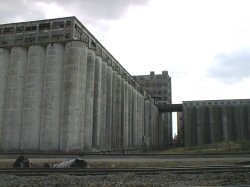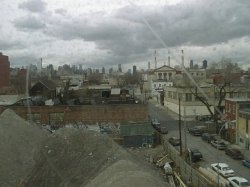Secret New York
Today, we look for the secret places that complete a city. The University of Houston's College of Engineering presents this series about the machines that make our civilization run, and the people whose ingenuity created them.
Years ago I read something that stayed with me. It was about Brasilia, the new planned capital city of Brazil, built between 1956 and '60. In its early days, Brazilians didn't want to move there, because it was all clean and out in the open -- no dark corners, no secret places or surprises.
Houston is a young city, yet it teems with surprises. Now and then my wife and I go out just to turn over stones. We find parks we'd never seen, The Beer Can House, the Houston underground, industrial back lots, foreign shipping, wild ostentation almost hidden from view, abandoned factories.
A city is no city without those places, and few cities have accumulated as many as New York has. Stanley Greenberg's new photo book, Invisible New York, provides a stunning look at the hidden warrens in that huge city. It's a small glimpse, only 52 pictures, but those pictures make the point.
Greenberg takes us into dank underground chambers we never knew were there. We see great rooms with bundles of cables being split off from a huge main bundle. Have you ever wondered how the suspension cables of the Brooklyn or Verrazano- Narrows Bridges are grasped and held within the earth? They're unwound, and small clumps of cables are anchored separately, distributing the vast tension of the cable into the ground.
Here's a forgotten catacomb that provided access while the Brooklyn Bridge was being built. Then it served for years as a wine-merchant's storage vault. An old subway tunnel couldn't accommodate newer trains, so it was abandoned. Now its mosaic ceiling looks like Neolithic cave painting. Another vast subterranean gallery holds banks of valves that regulate the city's water flow.
Then Greenberg takes us up above ground -- into the hidden catwalk above the Grand Central Station gallery, into the attic above the roof of St. John The Divine Cathedral. We walk into the works of the city's oldest mechanical clock, situated in the tower of an old office building. He shows us Con Edison's huge main turbine bay. One turbine generates 300 megawatts. Another generates a full gigawatt -- enough power to supply ten million light bulbs.
Finally we see what Shakespeare called "this muddy vesture of decay," a city's worn-out clothing. The old Roosevelt Island Lunatic Asylum, built in 1839, is a mad multistoried octagonal building, falling into disrepair. It might well be a Gothic movie set.
Old wreckage lines New York's waterfront: tangled metal of piers destroyed by fire, an abandoned dry dock, remains of an old barge terminal. It's a Mad Hatter's tea party of a place -- elements left behind as they're replaced with something better. In the end, we see that we aren't really part of a place until we know these secret places. For each is a mystic nexus -- a place where the seam between present and history, for a moment, becomes visible to us.
I'm John Lienhard, at the University of Houston, where we're interested in the way inventive minds work.
(Theme music)
Greenberg S., Invisible New York: The Hidden Infrastructure of the City. Baltimore: The Johns Hopkins University Press, 1998.
I am grateful to Margaret Culbertson, UH Art and Architecture Library, for steering me to Greenberg's affecting photo study.




We all have such places we savor. For me: Topiary contributed to a Houston public street, Port of Galveston, Houston grain elevators, and a scene from an elevated train in Queens.
(Photos by John Lienhard.)